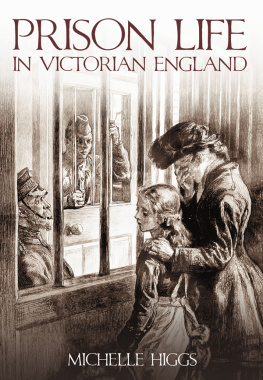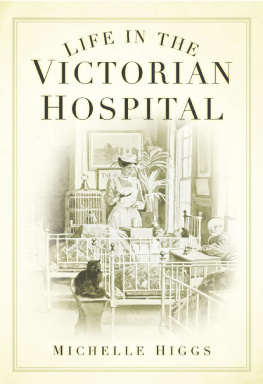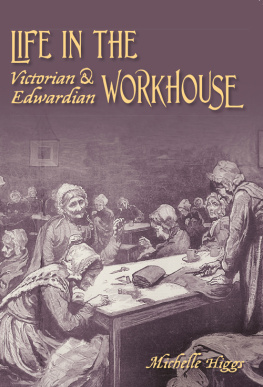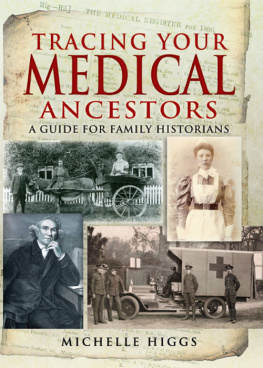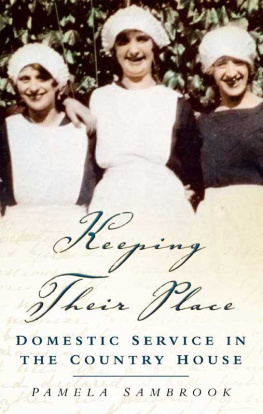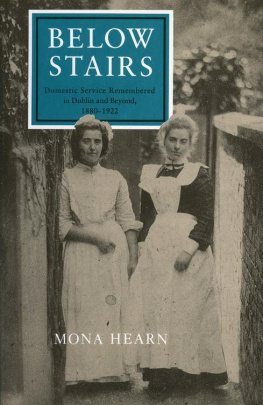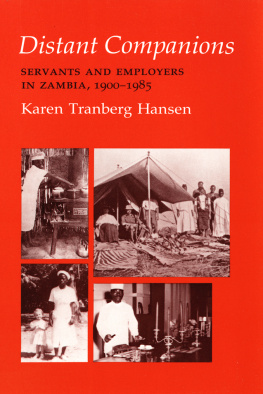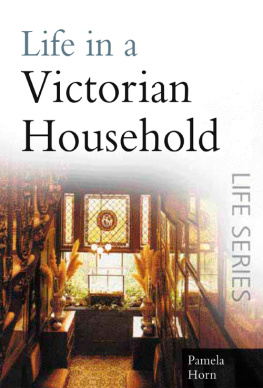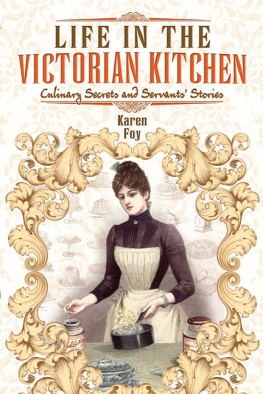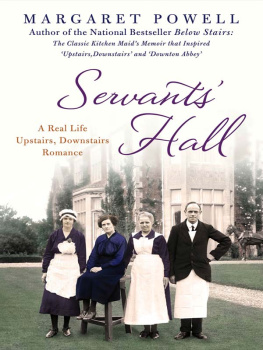For my grandmother, and all those
who toiled in domestic service
First published in Great Britain in 2015 by
Pen & Sword History
an imprint of
Pen & Sword Books Ltd
47 Church Street
Barnsley
South Yorkshire
S70 2AS
Copyright Michelle Higgs 2015
ISBN: 978 1 47382 224 5
PDF ISBN: 978 1 47387 165 6
EPUB ISBN: 978 1 47387 164 9
PRC ISBN: 978 1 47387 163 2
The right of Michelle Higgs to be identified as the Author of this Work has been asserted by her in accordance with the Copyright, Designs and Patents Act 1988.
A CIP catalogue record for this book is available from the British Library
All rights reserved. No part of this book may be reproduced or transmitted in any form or by any means, electronic or mechanical including photocopying, recording or by any information storage and retrieval system, without permission from the Publisher in writing.
Typeset in Ehrhardt by
Mac Style Ltd, Bridlington, East Yorkshire
Printed and bound in the UK by CPI Group (UK) Ltd,
Croydon, CRO 4YY
Pen & Sword Books Ltd incorporates the imprints of Pen & Sword Archaeology, Atlas, Aviation, Battleground, Discovery, Family History, History, Maritime, Military, Naval, Politics, Railways, Select, Transport, True Crime, and Fiction, Frontline Books, Leo Cooper, Praetorian Press, Seaforth Publishing and Wharncliffe.
For a complete list of Pen & Sword titles please contact
PEN & SWORD BOOKS LIMITED
47 Church Street, Barnsley, South Yorkshire, S70 2AS, England
E-mail:
Website: www.pen-and-sword.co.uk
Contents
Mary Ann Ashford:
William Tayler:
Hannah Cullwick:
Louise Jermy:
Elizabeth L. Banks:
Amy Grace Rose:
John Robinson:
Alice Eleanor Furman:
Cis Parker:
Jessie Stephen:
Mollie Prendergast:
Edith Hall:
Queenie Harris:
Cissie Ewen:
Marian Isobel Taylor:
Dolly Davey:
Elsie:
Lily Kerry:
David Dixon:
Daphne Jones:
Amy Jones:
Acknowledgements
I t is impossible to write a book like this without the help of a great number of people. While working on Servants Stories, I received assistance and advice in locating information and illustrations from a number of different sources.
For permission to reproduce extracts or images, I would like to express my gratitude to Jackie Brown of the British Library; Amy Sell of the British Newspaper Archive; the staff of Cambridgeshire Archives; Judy Davies of Codsall and Bilbrook Local History Society; the staff of the LSE Library; Peter Leigh of Pattingham Local History and Civic Society; Jane Mace, former editor of the SE1 Peoples History Project; Liz Stanley and Virago Press; Dr Mike Wood and the St Marylebone Society; Howard Dixon of Staffordshire and Stoke on Trent Archive Service; Sarah Williams of Tamworth Castle; Victoria Rimmer of the Walsall Local History Centre; and Kathryn Coles of the Workers Educational Association.
Thanks are also due to Jen Newby, who first commissioned me for this project; to Eloise Hansen, my editor at Pen & Sword; to Helen Harwood, whose website alerted me to the existence of Amy Grace Roses reminiscences; and to the staff of Who Do You Think You Are?, Family Tree, Your Family Tree and Best of British magazines, who publicised the fact that I was looking for servants stories.
I would also like to thank the following people, who so generously shared their stories and research: Jenni Dobson, for the information about her grandmother Mary Doughty; Hilary Donaldson, for granting permission to publish extracts from an oral history interview given by her grandmother Cis Parker; Peter Few, for allowing me to reproduce the letter from his ancestor Louisa Mist; Angela Richardson, for the details about her family friend Doris Hailwood; and Anne Simmonds, for granting permission to publish extracts about her aunt, Marian Taylor from her unpublished biography, The Singing Centenarian.
Special thanks go to the ex-servants and families of former servants with whom I was privileged to correspond and interview during the writing of this book: Reverend David Dixon; John Ewen, Kathleen McNeill and Anne Newton; Lindsay Hall; Pam Harris; Amy Jones; Daphne Jones and Colin Jones; Lily Kerry, Robert Kerry and Elizabeth Yule; and Rebecca Marsh.
Finally, I would like to thank my husband Carl for his continued support, and my family and friends for their encouragement during the writing of this book.
List of Illustrations
E very effort has been made to trace copyright holders of images included in this book. The publishers would be grateful for further information concerning any image for which we have been unable to trace a copyright holder.
Front cover image: Servants at Drayton Manor, Staffordshire, circa 1900. (With thanks to Tamworth Castle, ref. PH1247)
. Image Local World Limited. Image created courtesy of THE BRITISH LIBRARY BOARD)
Introduction
M y grandmother worked in domestic service in the late 1920s but, as she died when I was in my teens, I never had the chance to ask about her experiences. Researching and selecting the extracts for this book has given me a greater understanding of what her working life might have been like.
When I researched a previous book on domestic service, Tracing Your Servant Ancestors (Pen & Sword, 2012), most of the sources I came across represented the employers point of view. This book tells the servants side of the story, warts and all, and my grandmother would doubtless recognise many of the scenarios described. I have concentrated on the lesser-known stories of ordinary men and women who worked as servants in smaller homes for the middle and lower-middle classes, rather than the minority employed by the aristocracy on their country estates. In fact, in 1871 almost two-thirds of Britains female domestic servants were classed as general servants in homes employing one or two maids. However, the opposite was true for male servants, as they were mostly found in households keeping large numbers of domestic staff.
As a nation, we are fascinated by domestic service; the high viewing figures for Downton Abbey and visitor numbers to country houses represent ample proof of this. It may be the relationship between servant and employer, or the contrast between their very different lives, that intrigues us so much; perhaps its the fact that domestic service so clearly represents the class divide; or we are simply nostalgic for lost Victorian and Edwardian values.
The stories in this book come from diaries, oral histories, autobiographies, letters, memoirs and newspaper reports; some are from sources now out of print, while others have never been published before. While reading these accounts, it must be borne in mind that it is impossible to generalise about the servant experience, since the nature of domestic service varied remarkably between employers. However, long hours, very hard work and an acutely felt loss of freedom are common themes in most of the stories reproduced here.
The period 18001950 saw huge changes in the roles of domestic servants, as well as the living conditions they could expect and their status in society. The 21 servants stories in this book encompass this timespan and they are arranged in chronological order of the year each individual first went into service. Original spellings and punctuation have been retained to preserve the integrity of the extracts. The servants stories appear alongside more general chapters about the nature of domestic service and the ways in which it altered during this period from going into service and the growing servant problem in the Victorian era through to Edwardian domestic service and the impact of war.


